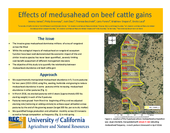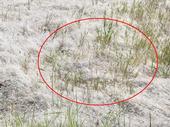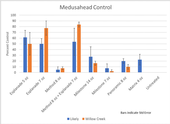- Author: Travis M Bean
New research published in PNAS (Fusco et al 2019) highlights the role of invasive grasses in creating new wildfire regimes at not just local but regional scales. Weed scientists are familiar with the concept of the grass-fire cycle (D'Antonio and Vitousek 1992): exotic grass invasions promote hotter or more frequent fires, which in turn facilitates more extensive grass invasion, causing more fires, etc. Perhaps now is the right time to better educate non-scientists about this critical concept as wildfires take up more of the public's...
- Author: Theresa A. Becchetti
- Posted by: Gale Perez

Here is a short summary written by Theresa Becchetti, University of California Cooperative Extension (UCCE) Livestock and Natural Resource Advisor on the Effects of Medusahead on Beef Cattle Gains project.
*******************
Livestock and Natural Resource Advisors, Specialists, and faculty have been researching Medusahead (an invasive grass with lower grazing quality) for many years now. We know it reduces carrying capacity on rangelands, creates a thatch that can become a fire hazard, and reduces the diversity of plants on rangelands to the extreme...
- Author: Thomas Getts

Last year about this time, I posted a blog regarding an ongoing trial investigating various herbicides for Pre-emergent Control of Medusahead. I wanted to follow up on that trial which I “deemed” unsuccessful and share some of the data collected in 2017.
The main objective of the study was to test various herbicides for medusahead control. I was interested if some of the work conducted at Colorado State with Esplanade (indaziflam) could be replicated with medusahead. In Colorado field trials, single applications of Esplanade had offered three-year...
- Author: Rebecca Ozeran
As you can tell by going through archived blogs on this site, medusahead (Taeniatherum caput-medusae) is an extremely popular grass. Well, an infamous one, perhaps. I am fairly certain that none of us actually like it. In this blog I will add to the plethora of medusahead posts; but first, a public service announcement.
On May 2, 2017, there will be a Medusahead Management Workshop at Lindcove REC, in Exeter. Online registration is available at ucanr.edu/medusahead. This workshop aims to inform attendees about medusahead biology, its economic impact on cattle operations, and a variety of tools available to...
- Author: Thomas Getts

I wanted to share some initial results from some medusahead trials I implemented this past year. Most of you are probably familiar with the invasive winter annual grass medusahead. If you follow this blog there have been numerous medusahead postings over the past years.
Now before I get going I wanted to point out this wonderful resource, The Medusahead Management Guide! It was published by the Weed Research Information Center in 2014, authored by Guy Kyser, Joseph DiTomaso, Kirk Davies, Josh Davy and Brenda Smith. There is a plethora of good information in this management guide and I encourage you to take a gander at it!
Link:


